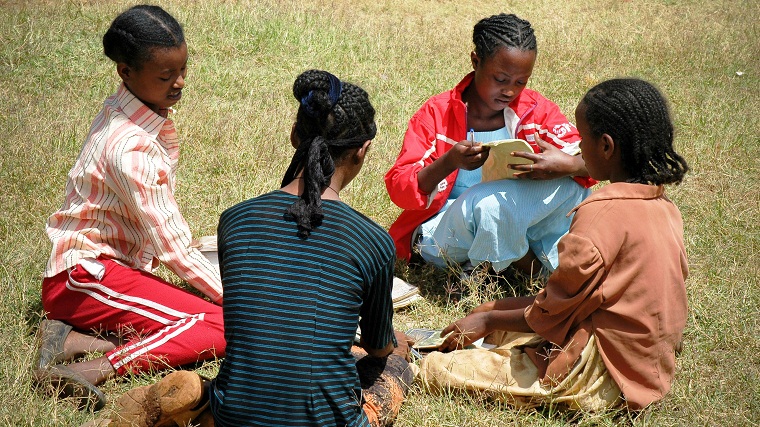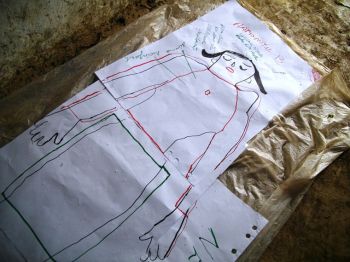Early Marriage in Ethiopia; In The Girls' Own Words
World Vision UK staffer Nell Williams recently travelled to Ethiopia to study the prevalence of early marriage and what can be done to give girls their childhood back. Here’s what she found on her visit: 
By Nell Williams, Marketing Communications Officer, World Vision UK
I never expected Ethiopia to be so green. I still had images from Live Aid and the Wollo famine in my mind. Growing up, that was the only picture I had of Africa. I expected it to be dusty and dry. But the places I visited were lush and green; hilly landscapes shrouded in mist, dotted with goat herds, camels and coffee plantations.

I interviewed parents, children, community workers, faith leaders, police, teachers and many more as part of the research. But I learned most from the girls.
Outlining the problem
Girls were invited to come and talk to us in groups, in their school building. We gathered in a classroom and sat on the floor in a circle. The girls were shy at first but soon opened up. I placed a large sheet of paper on the floor and asked for a volunteer to lie down so we could trace their silhouette, making the shape of a girl. The children then took it in turns to draw a face, hair, clothes and shoes, bringing her to life. They named her Haimanot and decided she was 13 years old.
The girls then used their imaginations to describe her life to me. This helped them to communicate their experiences without having to go into personal details about themselves in the first-person. It’s our priority at World Vision that children are made to feel safe and protected when opening up about sensitive issues like this.
Haimanot's story
They brought Haimanot to life so passionately. No longer shy, they raised their hands eagerly to help tell Haimanot’s story. I prompted from time to time to help us explore the topic. It went like this:
“Haimanot is in grade 6 at school and doing very well. She helps out lots at home, caring for the little ones, cooking, cleaning and fetching water. Sometimes she has to carry heavy firewood a long way, but she doesn’t mind. The boys look after the animals, but the girls do most of the work.
Her family love her very much. Her neighbours do too, because she is always helpful and polite. She loves school but she’s worried that her parents will ask her to quit soon. They need the help at home.
Haimanot can play when she has done her chores. But she doesn’t go far. She’s afraid that wild animals or older boys could attack her. Her elders give her advice – ‘don’t go out with men, stay away from boys and don’t go far’. They don’t want her to get abducted or get pregnant.
Haimanot’s body is starting to change, she is becoming a woman. This makes her feel stressed. Will she have to get married soon? If she gets pregnant how will she manage to give birth? How will she raise the child?  If Haimanot is scared, she can go to her Mum and Dad and they will protect her. She can also talk to a kind teacher at the school, or go to the police. They will help her.”
If Haimanot is scared, she can go to her Mum and Dad and they will protect her. She can also talk to a kind teacher at the school, or go to the police. They will help her.”
Though this is an imaginary story, it draws on the girls’ own experiences – the lives they have and see around them. In this simple activity they taught me so much.
A sad and shocking reality
I knew the rates of child marriage in Ethiopia, but I was still sad to hear the reality; that girls dread their bodies changing, because they know that could mean the end of their childhood.
I was shocked to hear that 13-year-old girls have a very real fear of being raped or attacked. I never thought of those things as a child - these things simply should not be in their world.
I also met with many parents and most of them wanted more than marriage for their girls. They wanted them to finish school, do well and be happy.
But they also wanted them to eat well, to be looked after and protected. Most of all, they wanted them to survive, and they equated survival with marriage. Girls are married young when they don’t have other options.
I really believe that child sponsorship is helping to make sure there are other options. Helping families feed, educate and provide for their girls so they can choose a real childhood over marriage.
What’s more, it is making sure that girls like Haimanot have people to talk to in their community. Supporting teachers, faith leaders, police and other trusted adults they can turn to as they face these fears. That’s a very powerful thing.  Early marriage forms the cornerstone of our A Night of Hope campaign this Halloween - asking people to carve a heart into their pumpkin to turn it from a symbol of fear into a lantern of hope for girls around the world like Haimanot and Sylvia, who features heavily in our campaign.
Early marriage forms the cornerstone of our A Night of Hope campaign this Halloween - asking people to carve a heart into their pumpkin to turn it from a symbol of fear into a lantern of hope for girls around the world like Haimanot and Sylvia, who features heavily in our campaign.
Thanks to Nell for sharing her experience and the creative ways she approached a very sensitive subject. If you have any questions for Nell, she'll be responding to comments on our Facebook page.
